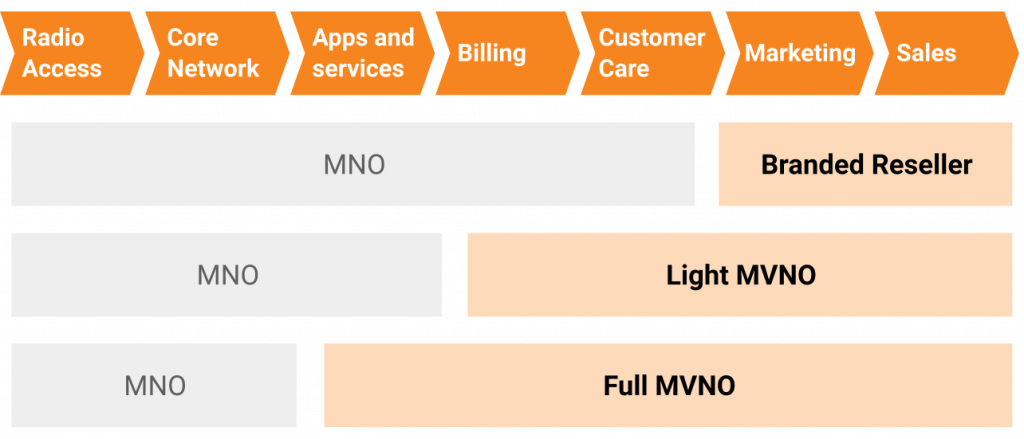Have you ever wondered why some tech companies rise to the top while others bite the dust? There are dozens of reasons, but one is absolutely fundamental. Economically speaking, it’s the market and its trends. That’s the reason our topic today is MVNO.
If you launch your idea before the market needs it, your business will have no customers. On the other hand, if you start your company when the market is fully settled, you’ll face fierce competition. The sweet spot is to ride the trend at exactly the right time. That’s when you can hit the jackpot.
There is one trend rising right now that has this sweet spot on the horizon. Its name is MVNO – or Mobile Virtual Network Operator.
The New Black in the Mobile Service Market
Let’s take a look at the stats behind this slice of the market. According to Global Market Insights, the market size for MVNO surpassed US$55 billion in 2017. In 2020, the same market was valued at US$67.54 billion. By 2028, it is expected to reach US$123.40 billion.

“But,” you ask, “MVNO isn’t a new business model. So why this rapid growth?”
Well, there are several reasons. First of all, remember that traditional mobile operators (MNOs) have a deep interest in the prosperity of the MVNO market. That’s because it promises to grow the MNO market along with it.
Second, the number of people who are using communication services is still growing, as are their needs. While some sectors have suffered in the global pandemic, telecommunications have boomed. For example, Vodafone has stated that the coronavirus crisis caused data traffic on its networks to surge, with demand rising over 50% in some markets. And the number of mobile phone users reached 3.6 billion in 2020, and aims to topple 4.3 billion by 2023. In fact, time spent on the mobile web increased 575% over the past three years.
Technology appears on the scene
But one of the main reasons for the increasing focus on MVNO is the development of eSIM, 5G, and IoT technologies. Gartner has recorded significant growth across device makers introducing e-SIMs into smartphones (18.2% penetration by 2021), as well as tablets and laptops (13.5%). And G + D Mobile Security estimates that there are likely to be around 2 billion devices connected with the help of e-SIM by the end of 2025.
On top of that, MVNOs have become important actors in the IoT connectivity process. Fact is, most IoT devices, one way or another, use the same type of connectivity that smartphones and tablets use. (And broadcast towers need this same connectivity type to function.) Selling IoT connectivity and data has come to the forefront in profitability – in fact, analysts estimate the IoT market’s revenue at US$906 billion by 2025.
Let’s Take a Break. What Is MVNO, Anyway?

Take a look at your phone. Almost certainly it has a card from a particular mobile operator. Let’s say it’s from AT&T if you’re in the US, Vodafone in the UK, or MTN in South Africa. (Keep that last country in mind, by the way – it comes up later.)
All of these brands are a so-called MNO, or mobile network operator. Each has a communication license, its own infrastructure, and specific capacities.
An MVNO, or virtual mobile network operator, is practically the same. But while they provide services under their own brand, they don’t have their own infrastructure. Instead, they lease the infrastructure of traditional providers. According to estimates, by 2025 there will be about 2,000 MVNO providers in the world.
But what about the competition, you may ask? MVNOs pay MNOs, so the latter also benefit when their tenant’s audience grows.
MVNO types
Not all MVNOs are the same. Some provide niche products for small audiences and specific tasks. If we’re talking specifically about the MVNO business model, it’s divided into subtypes:
- Branded resellers act as a sales channel for existing MNO branded products.
- Light MVNOs are an intermediate between a branded reseller and a full MVNO. In this model, you control the back office, decide which value-added services to provide to your clients, and manage your billing – you can set your own prices to differentiate yourself from your competitors.
- Full MVNOs include all of the infrastructure use, customer management, data, and billing in their operations. They have a mobile switching center (MSC), a home location register (HLR), and authentication center (AUC), as well as a mobile subscriber identity (IMSI) code, its own network code (MNC), a policy and charging rules function, and so one. They can issue their own SIM cards and offer services to end users.
It’s worth noting that quite a lot has been written about the features of each type. Here you can read a whole thread on Quora where users discuss the types and characteristics of all the different MVNO business models.

Business opportunities
MVNO has now victoriously emerged on almost every continent. In Denmark and Great Britain, the share of MVNOs in the telecom services market is already about 20%. After that come Asia Pacific and North America, according to GSMA Intelligence for 2015. Last year, even Google joined the MVNO movement in the US.
The growing interest in MVNO is being primarily driven by two factors. The first is regulatory. In European markets, telecom regulators are encouraging the creation and development of virtual operators, as they see this as an incentive for competition.
The situation is similar in emerging markets. MVNOs have already appeared in the Pacific region and in South America. And remember how we told you to keep South Africa in mind? This market has been experiencing a huge rise in this type of business. That’s partly due to price-savviness in many communities, who seem to prefer mobile operators that offer the lowest cost.
MVNO is the tech growth engine
Another reason for the increased interest in MVNO is its technology. One way or another, buzzwords like Big Data, IoT, blockchain and others are also creating more opportunities for MVNOs. For example, machine learning with data analytics could support improved customer personalization. 5G network slicing will make it easy for MVNOs to switch from one network to another to serve varied business use cases, such as tracking IoT devices.
And according to Kaleido Intelligence, so-called IoT MVNOs were servicing 134 million connections at the end of 2019, an increase of 73% since 2017.
Who Can Launch an MVNO?
We’re finally getting to the fun part. You – that’s right, you – can start your own MVNO. And let’s even imagine you’ve already decided to do it. To make it easier on yourself, you’ll likely opt for selling a niche product tailored to a specific audience, such as Discount, Business, Media & Entertainment, Migrant, Retail, Roaming, or Telecom. Or, if you’re a traditional business such as a banks, let’s say you want to launch an MVNO to offer a bundle offer to your customers (with convenient banking and cheap communications included).
Why? Because, just like with any business, you need to start with a strong idea to set yourself apart. No shortcuts or mind-blowing insights here!
I have an MVNO idea. What’s next?
Usually, the path from idea to implementation is pretty standard. It consists of several steps.
Step 1: The agreement with an MNO. Since an MVNO does not have its own radio infrastructure, you need to find out where to get one. To do this, you need to contact the mobile network operator in your market and sign a so-called roaming agreement with them. Learn more about this type of document here.
Step 2: Decide what type of MVNO you want to be. The configuration and infrastructure of your core network are going to depend on this. The more complete and advanced the solution, the bigger your capabilities should be. You can read about the difference in solutions in one of our white papers.
Step 3: Find a reliable technology provider. If you don’t have your own telecom development team, it’s better to shift the architecture, implementation, configuration, and other service things to those who have such experience. It’s worth noting here that you are reading the blog of a company that has 300 engineers with exactly this relevant specialization right now.
Step 4: Marketing and billing. MVNO is a business model, so you need to know where, why, and how to bill your customers. There are dozens of established strategies, as well as emerging ones. Which one to choose is entirely up to you.
For more details to ensure a smooth start on your journey to becoming an MVNO, see our custom-made MVNO checklist, which detail what you need to know.
The cost and connection
On average, the investment for launching an MVNO is about US$500,000. And, like with any tech business, the success of your future project directly depends on the quality of its implementation. Supplying a service over a mobile network requires the following components:
- Core network for 3G networks or EPC (evolved packet core) for 4G. This is your home network that communicates with the MNO. It consists of a set of components such as HLR (a centralized repository of subscriber data), MSC (voice call switching), SGSN (data switching), and so on. Nowadays, your MNO usually provides such mobile core elements, along with the radio network.
- BSS (business support system). This is what’s keeping your customer data, such as personal info and their service package. Your BSS then provisions the information in CN components to ensure customers can use the service properly.
- OCS (online charging system). This performs real-time checks of the customer’s balance, and calculates the amount to charge for the consumed services (e.g., phone calls) to ensure there is no unauthorized usage or balance overdraft.

Getting in the flow
Keep in mind that the set of components you need depends on the model and business plan you have chosen (for example, Brand Resellers doesn’t have any of these). And the flow of launching or supporting a healthy business with PortaOne goes in a particular pattern to ensure your needs are met. First, we meet with you to look at your business plan, analyze your current number of clients, and find out how many new ones you want to attract in the year to come. Then, we carry out redundancy and select the system and architecture that will allow us to provide results and scalability.
You’ll also need to integrate with a CRM system, accounting system, ERP, or another module – for all of that, you can use iPaaS from PortaOne.
Billing subscribers
Once again, there’s no uniform approach. It all depends on your business model and the functions that you provide to your users. But no matter what you’re selling – calls, messages, or megabytes – there are unified tools to bill for them. Often this is the most complex and essential part of the project.
Our billing solution is called PortaBilling. This is a single administration interface to manage and bill for multiple services. The first function of PortaBilling is clear from its name: it automates accounting for users and for the services they use, then it charges them. The functionality also supports almost any payment method your customers want to use: debit, e-wallets, PayPal-type services, or a local payment option like Africa’s M-Pesa or Germany’s Girocard. PortaBilling also allows you to charge amounts in real-time, store the data, then transfer it if needed for post-payment (a.k.a., a mediation service).
The second important billing function is the so-called service provisioning. This is used to configure the service parameters, and acts as a central repository of customer data. Thanks to this functionality, any changes to your business support systems are instantly provisioned to your HLR and other network elements. This allows for accurate accounting and cash flow management.
Developing Your MVNO
You’ve probably heard the phrase “innovate or die” before. While no one is saying this specifically about MVNO just yet, there’s plenty of room for growth in this sector. Remember way back in this post, when we listed the types of MVNOs? Well, we deliberately skipped one: the so-called MVNE, or mobile virtual network enabler.
The MVNE model is an intermediary between ordinary and virtual operators. MVNEs deal exclusively with technical issues. So, if you are a Full MVNO, you can also rent out this service to other operators who do not want to bother with technical issues.
Really, there is a division of responsibilities between MNOs, MVNEs, and MVNOs: the first one organizes the process and licenses services, the second provides the technical ability to actually service subscribers, and the third develops tariff plans, issues SIM cards, and promotes products. It’s all an excellent example of how your individual technique can start to work for you. Of course, that’s subject to the availability of those who want to launch their MVNO.
Instead of Inspiration

Of course, we couldn’t wrap up without a few PortaOne client success stories. Perhaps some will match with your business thoughts, and soon we’ll be sitting in our office (okay, having a virtual meeting) and discussing your MVNO project.
Peerless — A US-based global VoIP provider focused on customized, scalable, and high-quality business communications. They started with a successful test of their MVNO solution on top of the Sprint network. After a great launch and the PoC stage, Peerless decided to start its own MVNE business.
MegsApp / MegsConnnect — This is the first big MVNO in South Africa. They offer cheap bundles on voice, SMS, and data. They use MTN infrastructure, with PortaOne as the main developer for their MVNO architecture.
TravelSIM — Since 2006, this Australian MVNO has provided a mobile service for international travelers through prepaid international roaming SIM cards. The brand had over 400,000 subscribers at its peak, but as they were focused on only travel, they could not survive the COVID-19 border lockdown.
Aiva MTT – This is a mobile operator for immigrant communities in Russia. It offers a SIM card with two numbers, which helps clients stay connected in Russia and in their home country at bargain prices.
HelloSIM – This G-Mobile service in Armenia offers a roaming SIM card that operates in 200+ countries. PortaOne developed their custom-built network core, which is connected with the PortaBilling BSS. This allowed G-Mobile to lower their operational costs significantly. In our estimation, the total cost of operation for this solution is 65% lower than an off-the-shelf option. It is also 80% lower than renting the infrastructure from an MVNE.
Rain – This is an African MVNO that specializes in data-only tariffs. Rain offers 4G and 5G services for mobile phones as well as for homes.
DeskPhone – This UK provider of office systems used a Mobile-X/PortaSwitch integration to create a brand-new service for their clients: a mobile phone system with a landline number that doesn’t require Internet or OTT apps.
We Are Here to Help
A comment from DeskPhone has earned the right to act as our conclusion: “We were impressed with how easy it was to integrate both platforms, allowing us to offer our market-leading business communication services in the UK. PortaOne and Tango Networks were keen and responsive in helping us build our product, and we value them as true partners in our success.”
Stay tuned for more on this growing sector, and don’t hesitate to drop us a line if this post has you thinking about your own MVNO.

